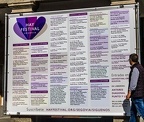Home / My Travels / Spain, Portugal and Gibraltar, September 2019 / Segovia Spain, September 7, 2019 378
Segovia is a small city best known for the Roman aqueduct that runs right across the city center plaza. The center is a mixture of medieval and more modern buildings, surrounded by more recent buildings and then agricultural lands.
In addition to the aqueduct, I visited the 16th century cathedral and the Alcázar de Segovia, a restored 12th century castle.
This is a good time to discuss what one is seeing when it comes to Roman or Middle Age structures. Don't assume that what you see has been just like it was when built. Portions of the aqueduct collapsed on occasion, from earthquakes (I recall) and other causes. It has been rebuilt in what is close to its original form on several occasions. It still carried water to the city until the mid 1800's. It appears much as it did in Roman times.
This is very different than the "Roman Bridges" that seem to exist in many cities. Yes, the Romans built a bridge, probably close to the one you see, but you can be pretty certain that that bridge (and its successors) were washed out in the floods that occur on those rivers. Some foundations from Roman times may survive, but the actual structure you walk across is relatively new. For instance, the Romans did not install electric street lighting with buried utilities on their bridges. Actually if you want a clue whether the masonry is original (or at least accurately restored original) look for mortar between the stones. The Romans may have used concrete, but they did not use mortar in the joints of their stonework. I'll continue this discussion, particularly as it applies to buildings, later on in my journey.
In addition to the aqueduct, I visited the 16th century cathedral and the Alcázar de Segovia, a restored 12th century castle.
This is a good time to discuss what one is seeing when it comes to Roman or Middle Age structures. Don't assume that what you see has been just like it was when built. Portions of the aqueduct collapsed on occasion, from earthquakes (I recall) and other causes. It has been rebuilt in what is close to its original form on several occasions. It still carried water to the city until the mid 1800's. It appears much as it did in Roman times.
This is very different than the "Roman Bridges" that seem to exist in many cities. Yes, the Romans built a bridge, probably close to the one you see, but you can be pretty certain that that bridge (and its successors) were washed out in the floods that occur on those rivers. Some foundations from Roman times may survive, but the actual structure you walk across is relatively new. For instance, the Romans did not install electric street lighting with buried utilities on their bridges. Actually if you want a clue whether the masonry is original (or at least accurately restored original) look for mortar between the stones. The Romans may have used concrete, but they did not use mortar in the joints of their stonework. I'll continue this discussion, particularly as it applies to buildings, later on in my journey.

 Segovia Spain, September 7, 2019
Segovia Spain, September 7, 2019
128 hits Segovia Spain, September 7, 2019
Segovia Spain, September 7, 2019
74 hits Segovia Spain, September 7, 2019 _180
Segovia Spain, September 7, 2019 _180
86 hits Segovia Spain, September 7, 2019 _360
Segovia Spain, September 7, 2019 _360
73 hits Segovia Spain, September 7, 2019 _180
Segovia Spain, September 7, 2019 _180
89 hits Segovia Spain, September 7, 2019
Segovia Spain, September 7, 2019
74 hits Segovia Spain, September 7, 2019
Segovia Spain, September 7, 2019
70 hits Segovia Spain, September 7, 2019
Segovia Spain, September 7, 2019
81 hits